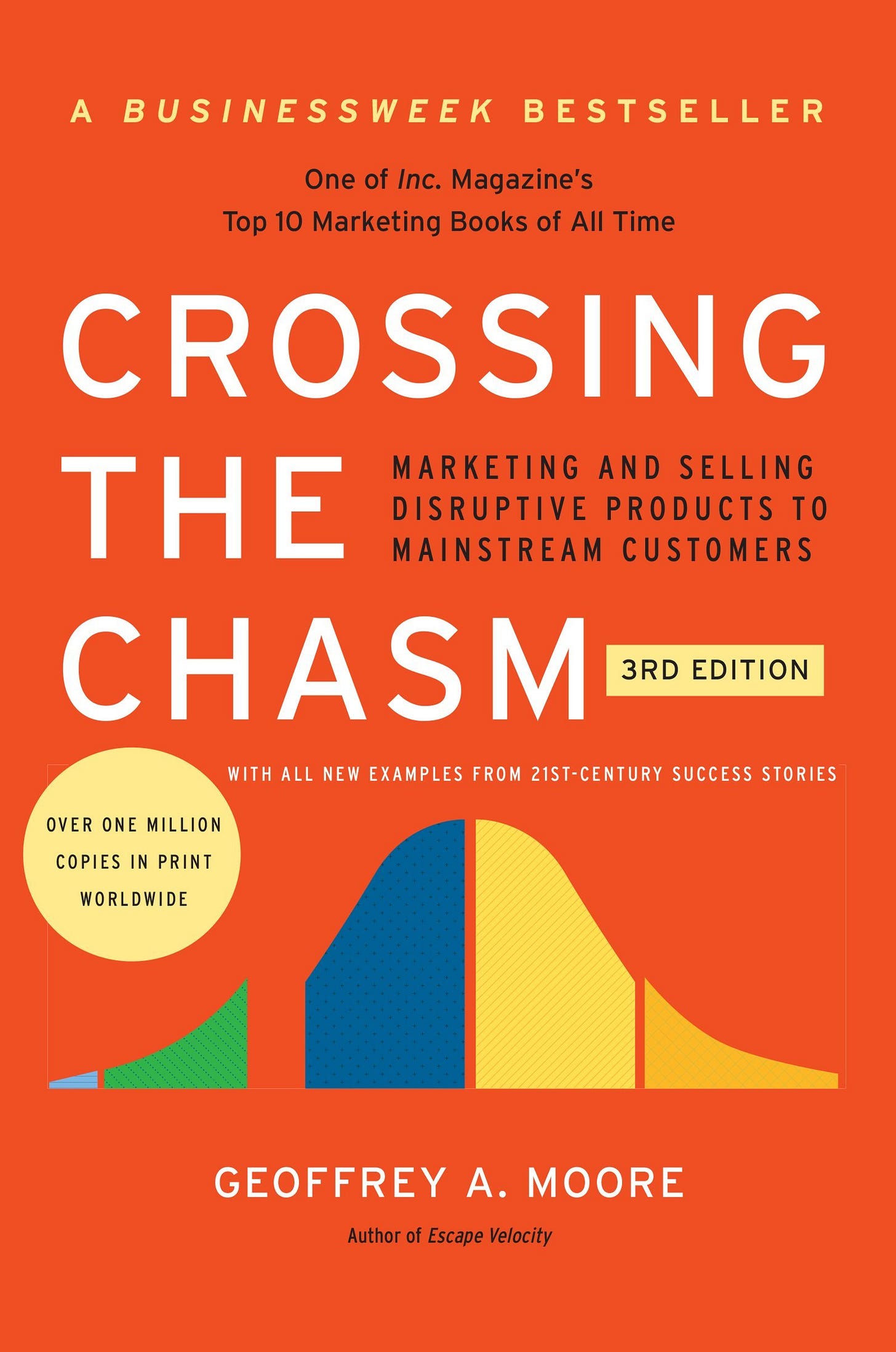This month we’re reviewing the classic marketing and product book: Crossing the Chasm by Geoffrey Moore.
This book has been through several editions, which speaks to its usefulness and longevity. If you’ve read some of the earlier versions (like I have), you’ll understand the need for the updates. The principles are great, though certainly have evolved over the past 20 years, especially with the rise of the internet. But the examples have rapidly gotten out-of-date. Even in the newest edition, it feels like some of the examples are already outdated.
Regardless, this one is a classic for a reason. And ultimately has enough great content that anyone working in technology, whether product, marketing, or sales, needs to be familiar with the concepts.
Overview
The chasm is the place where many companies and products die. Companies that fail to reach mainstream success, as we’ll discuss further, end up never successfully crossing the chasm. But it doesn’t have to be that way according to this book.
By understanding that there is a chasm, and companies and products have to move from early adopters to the mainstream, we stand a much better chance by changing our tactics and approach to better accommodate the market conditions.
Let’s dive in.
Key Ideas
Adoption Lifecycle
The key idea behind Crossing the Chasm is that there is an adoption lifecycle for technology.
The chasm is the space between the early market and the mainstream market.
It begins with innovators, who are at the bleeding edge of technology adoption. They are willing accept all sorts of problems with technology as long as they get to be first. They are what the book calls the “technology enthusiasts” who love technology for its own sake.
Next are the early adopters, or the the “visionaries” as the book calls them. They are also early in the adoption cycle, and are the people who can match the early technology with the opportunities. They are willing to take risks, but do so in order to vastly improve things or make big breakthroughs.
After early adopters, we find the chasm—the space before the mainstream market. As we discussed previously, this is one of the most important divisions in the adoption lifecycle. Many products and companies can find success among early adopters, but are never able to move to the mainstream market.
The mainstream market is defined mainly by early majority and late majority adopters of technology.
Early majority adopters are characterized in the book as “pragmatists.” Pragmatists want quality software and want to buy into the “market leaders”.
Finally, the late majority is characterized as “conservatives.” They are cost sensitive, want a fully fleshed out experience without any bugs, and want it at the cheapest price since they aren’t at the forefront.
Customer Segments
Each customer segment along the technology adoption lifecycle is different, and needs a different approach from a technology company, and everyone in it. This includes marketing, sales, and product development.
Early adopters do not need a fully developed, or fully baked, product. They don’t need all the support and guidance either. So we, as product managers, UX designers, marketers, etc, can keep these things in mind as we’re developing and launching our products.
But as we move further along the adoption lifecycle, we also have to understand the customer needs and how they change. From needing more support within the product to needing a simpler experience from onboarding to usage.
Having this lifecycle as a framework is incredibly helpful for anyone working in technology, because we’re often working with customers all along the lifecycle, but our company and our product is likely more focused in a specific space. And as we progress, we can better understand what we need to do to more fully reach the next customer segment.
Focus
The key to crossing the chasm is focus. In one of my previous roles we liked to call it “land and expand.” And this book uses a similar metaphor when thinking about how to go from an early market to a mainstream market.
“Cross the chasm by targeting a very specific niche market where you can dominate from the outset, drive your competitors out of that market niche, and then use it as a base for broader operations. Concentrate an overwhelming superior force on a a highly focused target.”
The problem so many companies face is the difficulty in focusing. I’ve seen this so many times. It is a symptom of being sales-driven and sales-led. It is impossible to say no to a sale, and because of that, a company and a product spreads itself across all possible market niches and options rather than focusing on one and doing it well.
“Instead, the claim is made that, although niche strategy is generally best, we do not have time—or we cannot afford—to implement it now. This is a ruse, of course, the true answer being much simpler: We do not have, nor are we willing to adopt, any discipline that would ever require us to stop pursuing any sale at any time for any reason. We are, in other words, not a market-driven [or product-driven] company; we are a sales-driven company.”
So…
Crossing the Chasm by Geoffrey Moore is a classic for good reason. The principles are as relevant today as they were 20 years ago. And while the companies continually change, the need to understand that our marketing, sales, and product development need to adapt in order to meet the needs of the right group of customers at the right time will always be constant.
It’s easy to get lost in our current customers, especially for early technology products. But by keeping the chasm in mind, and understanding we need to adapt our products (and companies) to cross the chasm and reach the mainstream, we can avoid becoming another body in the void.







